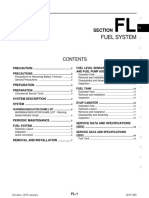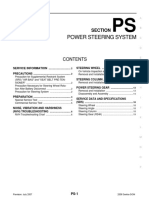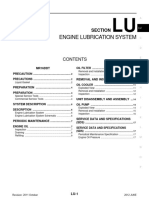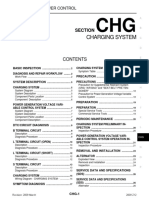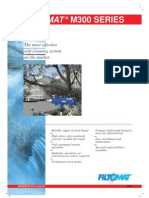Engine Lubrication System: Section
Engine Lubrication System: Section
Uploaded by
jasleenCopyright:
Available Formats
Engine Lubrication System: Section
Engine Lubrication System: Section
Uploaded by
jasleenOriginal Description:
Original Title
Copyright
Available Formats
Share this document
Did you find this document useful?
Is this content inappropriate?
Copyright:
Available Formats
Engine Lubrication System: Section
Engine Lubrication System: Section
Uploaded by
jasleenCopyright:
Available Formats
ENGINE
LU
A
LU
SECTION
ENGINE LUBRICATION SYSTEM C
E
CONTENTS
PRECAUTION ............................................... 2 OIL FILTER ....................................................... 11 F
Removal and Installation .........................................11
PRECAUTIONS ................................................... 2
Precaution for Supplemental Restraint System REMOVAL AND INSTALLATION ............... 12 G
(SRS) "AIR BAG" and "SEAT BELT PRE-TEN-
SIONER" ................................................................... 2 OIL COOLER .................................................... 12
Precaution for Liquid Gasket ..................................... 2 Exploded View .........................................................12
Removal and Installation .........................................12 H
PREPARATION ............................................ 4
OIL PUMP ......................................................... 14
PREPARATION ................................................... 4 Exploded View .........................................................14
I
Special Service Tool ................................................. 4 Removal and Installation .........................................14
Commercial Service Tool .......................................... 4
UNIT DISASSEMBLY AND ASSEMBLY ... 16
SYSTEM DESCRIPTION .............................. 6 J
OIL PUMP ......................................................... 16
LUBRICATION SYSTEM .................................... 6 Disassembly and Assembly .....................................16
Lubrication Circuit ..................................................... 6 K
Schematic ................................................................. 7 SERVICE DATA AND SPECIFICATIONS
(SDS) ............................................................ 18
PERIODIC MAINTENANCE .......................... 8
SERVICE DATA AND SPECIFICATIONS L
ENGINE OIL ........................................................ 8 (SDS) ................................................................. 18
Inspection .................................................................. 8 Standard and Limit ..................................................18
Changing Engine Oil ................................................. 9 M
Revision: August 2012 LU-1 2012 Titan
PRECAUTIONS
< PRECAUTION >
PRECAUTION
PRECAUTIONS
Precaution for Supplemental Restraint System (SRS) "AIR BAG" and "SEAT BELT
PRE-TENSIONER" INFOID:0000000007308335
The Supplemental Restraint System such as “AIR BAG” and “SEAT BELT PRE-TENSIONER”, used along
with a front seat belt, helps to reduce the risk or severity of injury to the driver and front passenger for certain
types of collision. This system includes seat belt switch inputs and dual stage front air bag modules. The SRS
system uses the seat belt switches to determine the front air bag deployment, and may only deploy one front
air bag, depending on the severity of a collision and whether the front occupants are belted or unbelted.
Information necessary to service the system safely is included in the SR and SB section of this Service Man-
ual.
WARNING:
• To avoid rendering the SRS inoperative, which could increase the risk of personal injury or death in
the event of a collision which would result in air bag inflation, all maintenance must be performed by
an authorized NISSAN/INFINITI dealer.
• Improper maintenance, including incorrect removal and installation of the SRS, can lead to personal
injury caused by unintentional activation of the system. For removal of Spiral Cable and Air Bag
Module, see the SR section.
• Do not use electrical test equipment on any circuit related to the SRS unless instructed to in this
Service Manual. SRS wiring harnesses can be identified by yellow and/or orange harnesses or har-
ness connectors.
PRECAUTIONS WHEN USING POWER TOOLS (AIR OR ELECTRIC) AND HAMMERS
WARNING:
• When working near the Airbag Diagnosis Sensor Unit or other Airbag System sensors with the Igni-
tion ON or engine running, DO NOT use air or electric power tools or strike near the sensor(s) with a
hammer. Heavy vibration could activate the sensor(s) and deploy the air bag(s), possibly causing
serious injury.
• When using air or electric power tools or hammers, always switch the Ignition OFF, disconnect the
battery, and wait at least 3 minutes before performing any service.
Precaution for Liquid Gasket INFOID:0000000007308336
REMOVAL OF LIQUID GASKET
• After removing the bolts and nuts, separate the mating surface and
remove the old liquid gasket using Tool.
Tool number : KV10111100 (J-37228)
CAUTION:
Do not damage the mating surfaces.
• Tap the seal cutter to insert it (1).
• In areas where the Tool is difficult to use, lightly tap to slide it (2).
WBIA0566E
LIQUID GASKET APPLICATION PROCEDURE
Revision: August 2012 LU-2 2012 Titan
PRECAUTIONS
< PRECAUTION >
1. Remove the old liquid gasket adhering to the gasket application
surface and the mating surface using suitable tool. A
• Remove the liquid gasket completely from the groove of the
liquid gasket application surface, bolts, and bolt holes.
2. Thoroughly clean the mating surfaces and remove adhering LU
moisture, grease and foreign material.
PBIC0003E
D
3. Attach the liquid gasket tube to the Tool.
Tool number : WS39930000 ( — ) E
Use Genuine RTV Silicone Sealant or equivalent. Refer to
GI-15, "Recommended Chemical Products and Sealants".
4. Apply the liquid gasket without breaks to the specified location F
with the specified dimensions.
G
WBIA0567E
• If there is a groove for the liquid gasket application, apply the H
liquid gasket to the groove.
• Normally apply the liquid gasket on the inside edge of the bolt
holes. Also apply to the outside edge of the bolt holes when
I
specified in the procedure.
• Within five minutes of liquid gasket application, install the mat-
ing component.
• If the liquid gasket protrudes, wipe it off immediately. J
• Do not retighten after the installation.
• Wait 30 minutes or more after installation before refilling the
engine with oil or coolant. K
SEM159F
CAUTION:
Carefully follow all of the warnings, cautions, notes, and procedures contained in this manual.
L
Revision: August 2012 LU-3 2012 Titan
PREPARATION
< PREPARATION >
PREPARATION
PREPARATION
Special Service Tool INFOID:0000000007308337
The actual shapes of Kent-Moore tools may differ from those of special service tools illustrated here.
Tool number Description
(Kent-Moore No.)
Tool name
ST25051001 Measuring oil pressure
(J-25695-1) Maximum measuring range:
Oil pressure gauge 2,452 kPa (25 kg/cm2, 356 psi)
S-NT050
ST25052000 Adapting oil pressure gauge to cylinder block
(J-25695-2)
Hose
S-NT559
KV10111100 Removing steel oil pan and rear timing chain
(J-37228) case
Seal cutter
NT046
KV10115801 Removing and installing oil filter
(J-38956) a: 64.3 mm (2.531 in)
Oil filter wrench
S-NT375
WS39930000 Pressing the tube of liquid gasket
( — )
Tube presser
S-NT052
Commercial Service Tool INFOID:0000000007308338
Revision: August 2012 LU-4 2012 Titan
PREPARATION
< PREPARATION >
Tool name Description
A
Power tool Loosening nuts, screws and bolts
LU
C
PIIB1407E
Deep socket Removing and installing oil pressure switch
Deep socket 26 mm
D
NT818
Revision: August 2012 LU-5 2012 Titan
LUBRICATION SYSTEM
< SYSTEM DESCRIPTION >
SYSTEM DESCRIPTION
LUBRICATION SYSTEM
Lubrication Circuit INFOID:0000000007308339
WBIA0399E
1. Exhaust camshaft 2. Intake camshaft 3. Main oil galley
4. Chain tensioner (Left bank) 5. Oil filter 6. Oil cooler
7. Oil pan 8. Oil strainer 9. Oil pump
10. Chain tensioner (Right bank)
Revision: August 2012 LU-6 2012 Titan
LUBRICATION SYSTEM
< SYSTEM DESCRIPTION >
Schematic INFOID:0000000007308340
LU
I
PBIC0134E
Revision: August 2012 LU-7 2012 Titan
ENGINE OIL
< PERIODIC MAINTENANCE >
PERIODIC MAINTENANCE
ENGINE OIL
Inspection INFOID:0000000007308341
OIL LEVEL
• Before starting the engine make sure the vehicle is parked on a flat
and level surface, then check the oil level. If the engine is already
running, turn it off and allow 10 minutes before checking.
• Check that the oil level is within the low (L) and high (H) range as
indicated on the dipstick.
• If the engine oil level is out of range, add oil as necessary. Refer to
MA-16, "FOR NORTH AMERICA : Fluids and Lubricants", (United
States and Canada), MA-17, "FOR MEXICO : Fluids and Lubri-
cants" (Mexico).
SMA954C
OIL APPEARANCE
• Check the engine oil for a white milky appearance or excessive contamination.
• If the engine oil is milky, it is highly probable that it is contaminated with engine coolant. Repair the broken
parts.
OIL LEAKS
Check for oil leaks around the following areas:
• Oil pan
• Oil pan drain plug
• Oil pressure switch
• Oil filter
• Oil cooler
• Intake valve timing control cover
• Intake valve timing control solenoid valve
• Front cover
• Mating surface between cylinder block and cylinder head
• Mating surface between cylinder head and rocker cover
• Crankshaft oil seal (front and rear)
OIL PRESSURE CHECK
WARNING:
• Be careful not to burn yourself, as engine oil may be hot.
• Put the A/T shift selector in the Park “P” position.
1. Check the engine oil level. Refer to LU-8, "Inspection".
2. Remove engine under cover or skid plate. Refer to EXT-15, "Removal and Installation".
3. Disconnect the oil pressure switch harness connector.
4. Remove the oil pressure switch (A).
WBIA0791E
Revision: August 2012 LU-8 2012 Titan
ENGINE OIL
< PERIODIC MAINTENANCE >
5. Install Tools.
A
Tool number : ST25051001 (J-25695-1)
: ST25052000 (J-25695-2)
LU
WBIA0571E
D
6. Start the engine and warm it up to normal operating temperature.
7. Check the engine oil pressure with engine running under no-load.
Unit: kPa (kg/cm2, psi) E
Engine Speed Approximate Discharge Oil Pressure*
Idle speed More than 98 (1.0, 14)
2,000 rpm More than 294 (3.0, 43) F
*: Engine oil temperature at 80°C (176°F)
G
CAUTION:
If the difference between the test results and the specification is extreme, check the oil passages
and oil pump for leaks and blockages.
H
8. After the inspections, install oil pressure switch as follows:
a. Remove old liquid gasket adhering to oil pressure switch and engine.
b. Apply liquid gasket and tighten oil pressure switch to the specification. I
Use Genuine RTV Silicone Sealant or equivalent. Refer to GI-15, "Recommended Chemical Prod-
ucts and Sealants".
J
Oil pressure switch torque : 14.8 N·m (1.5 kg-m, 11 ft-lb)
c. After warming up engine, make sure there are no engine oil leaks.
Changing Engine Oil INFOID:0000000007308342
K
WARNING:
• Be careful not to burn yourself, as the engine oil is hot. L
• Prolonged and repeated contact with used engine oil may
cause skin cancer. Try to avoid direct skin contact with used
engine oil. If skin contact is made, wash thoroughly with soap M
or hand cleaner as soon as possible.
1. Remove engine under cover (if equipped) using a power tool.
Refer to EXT-15, "Removal and Installation".
N
2. Warm up engine, and check for engine oil leaks. Refer to LU-8,
"Inspection".
3. Stop engine and wait for 10 minutes.
KBIA2498E O
4. Loosen oil filler cap, then remove drain plug.
5. Drain engine oil.
6. Install drain plug with new washer. P
CAUTION:
• Be sure to clean drain plug and install with new washer.
Oil pan drain plug : 34.3 N·m (3.5 kg-m, 25 ft-lb)
7. Refill with new engine oil. Refer to MA-16, "FOR NORTH AMERICA : Fluids and Lubricants", (United
States and Canada), MA-17, "FOR MEXICO : Fluids and Lubricants". (Mexico).
CAUTION:
Revision: August 2012 LU-9 2012 Titan
ENGINE OIL
< PERIODIC MAINTENANCE >
• The refill capacity depends on the engine oil temperature and drain time. Use these specifica-
tions for reference only.
• Always use the oil level gauge to determine when the proper amount of engine oil is in the
engine.
8. Warm up engine and check area around drain plug and oil filter for oil leaks.
9. Stop engine and wait for 10 minutes.
10. Install engine under cover (if equipped). Refer to EXT-15, "Removal and Installation".
11. Check engine oil level. Refer to LU-8, "Inspection".
Revision: August 2012 LU-10 2012 Titan
OIL FILTER
< PERIODIC MAINTENANCE >
OIL FILTER
A
Removal and Installation INFOID:0000000007308343
REMOVAL LU
1. Remove the engine under cover (if equipped) using power tool. Refer to EXT-15, "Removal and Installa-
tion"
2. Drain the engine oil. Refer to LU-9, "Changing Engine Oil". C
3. Remove the oil filter using Tool.
Tool number : KV10115801 (J-38956) D
WARNING:
• Be careful not to get burned when the engine and engine
oil are hot. E
CAUTION:
• The oil filter is provided with a relief valve.
• Use Genuine NISSAN oil filter or equivalent. F
• When removing, prepare a shop cloth to absorb any
engine oil leaks or spills. WBIA0388E
• Do not allow engine oil to adhere to the drive belt.
• Completely wipe off any engine oil that adheres to the engine and the vehicle. G
INSTALLATION
1. Remove foreign materials adhering to the oil filter installation surface. H
2. Apply engine oil to the oil seal circumference of the new oil filter.
K
SMA010
3. Screw the oil filter manually until it touches the installation sur- L
face, then tighten it by 2/3 turn. Or tighten to specification.
Oil filter : 17.7 N·m (1.8 kg-m, 13 ft-lb) M
4. Refill the engine with new engine oil. Refer to LU-9, "Changing
Engine Oil".
5. Inspect the engine for oil leaks. Follow the "INSPECTION N
AFTER INSTALLATION" procedure.
6. Install the engine under cover (if equipped). Refer to EXT-15,
"Removal and Installation". SMA229B
O
INSPECTION AFTER INSTALLATION
1. Check the engine oil level. Refer to LU-8, "Inspection".
P
2. Start the engine and check for engine oil leaks.
3. Stop the engine and wait for 10 minutes.
4. Check the engine oil level and add engine oil as required.
Revision: August 2012 LU-11 2012 Titan
OIL COOLER
< REMOVAL AND INSTALLATION >
REMOVAL AND INSTALLATION
OIL COOLER
Exploded View INFOID:0000000007308344
WBIA0790E
1. Oil pan (Upper) 2. Water hose 3. Water pipe
4. Water hose 5. Connector bolt 6. Oil filter
7. Oil cooler 8. O-ring 9. Relief valve
10. Water hose 11. Connector pipe 12. Gasket
A. To thermostat housing B. Refer to LU-11 C. To cylinder block
Removal and Installation INFOID:0000000007308345
WARNING:
Be careful not to burn yourself, as the engine oil and engine coolant may be hot.
NOTE:
When removing components such as hoses, tubes/lines, etc., cap or plug openings to prevent fluid from spill-
ing.
REMOVAL
1. Remove the engine under cover (if equipped). Refer to EXT-15, "Removal and Installation".
2. Drain engine coolant from the radiator. Refer to CO-11, "Changing Engine Coolant".
3. Disconnect water hoses from the oil cooler.
CAUTION:
Do not spill engine coolant on the drive belt.
4. Remove oil filter. Refer to LU-11, "Removal and Installation".
CAUTION:
Do not spill engine oil on the drive belts.
5. Remove connector bolt, oil cooler and O-ring.
CAUTION:
Revision: August 2012 LU-12 2012 Titan
OIL COOLER
< REMOVAL AND INSTALLATION >
Do not reuse O-ring.
A
INSPECTION AFTER REMOVAL
Oil Cooler
Check oil cooler for cracks. Check oil cooler for clogging by blowing compressed air through engine coolant LU
inlet. If necessary, replace oil cooler assembly.
Relief Valve
Inspect relief valve for movement, cracks and breaks by pushing the ball. If replacement is necessary, remove C
the valve by prying it out using a suitable tool. Install a new valve by tapping it in place.
INSTALLATION
Installation is in the reverse order of removal, paying attention to the following: D
• Confirm that no foreign objects are adhering to the sealing sur-
faces of the oil cooler or oil pan.
• Tighten the connector bolt after aligning the protrusion of the oil E
cooler with the stopper on the oil pan (upper).
G
KBIA2500E
INSPECTION AFTER INSTALLATION
• Before starting engine, check oil/fluid levels including engine coolant and engine oil. If less than required H
quantity, fill to the specified level. Refer to MA-16, "FOR NORTH AMERICA : Fluids and Lubricants" (United
States and Canada) or MA-17, "FOR MEXICO : Fluids and Lubricants" (Mexico).
• Use procedure below to check for fuel leakage. I
• Turn ignition switch ON (with engine stopped). With fuel pressure applied to fuel piping, check for fuel leak-
age at connection points.
• Start engine. With engine speed increased, check again for fuel leakage at connection points.
J
• Run engine to check for unusual noise and vibration.
NOTE:
If hydraulic pressure inside timing chain tensioner drops after removal and installation, slack in the guide
may generate a pounding noise during and just after engine start. However, this is normal. Noise will stop K
after hydraulic pressure rises.
• Warm up engine thoroughly to make sure there is no leakage of fuel, exhaust gas, or any oils/fluids including
engine oil and engine coolant. L
• Bleed air from passages in lines and hoses, such as in cooling system.
• After cooling down engine, again check oil/fluid levels including engine oil and engine coolant. Refill to spec-
ified level, if necessary.
• Summary of the inspection items: M
Item Before starting engine Engine running After engine stopped
Engine coolant Level Leakage Level N
Engine oil Level Leakage Level
Transmission/ A/T and CVT Models Leakage Level/Leakage Leakage
O
transaxle fluid M/T Models Level/Leakage Leakage Level/Leakage
Other oils and fluids* Level Leakage Level
Fuel Leakage Leakage Leakage P
Exhaust gas — Leakage —
*Power steering fluid, brake fluid, etc.
Revision: August 2012 LU-13 2012 Titan
OIL PUMP
< REMOVAL AND INSTALLATION >
OIL PUMP
Exploded View INFOID:0000000007308346
WBIA0415E
1. Oil pump body 2. Outer rotor 3. Inner rotor
4. Oil pump cover 5. Oil pump drive spacer 6. Regulator valve
7. Regulator spring 8. Regulator plug
Removal and Installation INFOID:0000000007308347
REMOVAL
1. Remove front cover. Refer to EM-49, "Removal and Installation".
2. Remove the oil pump drive spacer.
3. Remove the oil pump.
KBIA2512E
INSTALLATION
Installation is in the reverse order of removal.
• Align the crankshaft key and the flat face of the inner rotor before
inserting the oil pump drive spacer.
• Rotate the oil pump inner rotor by hand until the crankshaft key
and the inner rotor are aligned properly.
• Then tap lightly until the oil pump drive spacer reaches the end.
KBIA2490E
INSPECTION AFTER INSTALLATION
Revision: August 2012 LU-14 2012 Titan
OIL PUMP
< REMOVAL AND INSTALLATION >
• Start the engine, and check for engine oil and engine coolant leaks and repair as necessary.
• Stop engine and wait 10 minutes. A
• Check level and add engine oil as required. Refer to LU-8.
LU
Revision: August 2012 LU-15 2012 Titan
OIL PUMP
< UNIT DISASSEMBLY AND ASSEMBLY >
UNIT DISASSEMBLY AND ASSEMBLY
OIL PUMP
Disassembly and Assembly INFOID:0000000007308348
DISASSEMBLY
1. Remove oil pump cover.
2. Remove inner rotor and outer rotor from oil pump body.
3. Remove the regulator plug, regulator spring and regulator valve.
INSPECTION AFTER DISASSEMBLY
Clearance of Oil Pump Parts
• Measure radial clearance using a suitable tool.
Body to outer rotor : Refer to LU-18.
(position 1)
Inner rotor to outer : Refer to LU-18.
rotor tip (position 2)
PBIC0139E
• Measure side clearance using suitable tools.
Body to inner rotor : Refer to LU-18.
(position 3)
Body to outer rotor : Refer to LU-18.
(position 4)
PBIC0140E
• Calculate the clearance between inner rotor and oil pump body as
follows.
1. Measure the outer diameter of protruded portion of inner rotor
(position 5) using suitable tool.
PBIC0141E
Revision: August 2012 LU-16 2012 Titan
OIL PUMP
< UNIT DISASSEMBLY AND ASSEMBLY >
2. Measure the inner diameter of oil pump body to brazed portion
(position 6) using suitable tool. A
LU
PBIC0142E
D
3. Calculate the clearance using the following formula.
• (Clearance) = (Inner diameter of oil pump body) - (Outer diameter of inner rotor)
E
Inner rotor to brazed portion of : Refer to LU-18.
housing clearance
Regulator Valve Clearance F
Check regulator valve to oil pump cover clearance using the following formula.
• (Clearance) = D1 (Valve hole diameter) - D2 (Outer Diameter of
valve) G
Regulator valve to oil : Refer to LU-18.
pump cover H
CAUTION:
• Coat regulator valve with engine oil.
• Check that it falls smoothly into the regulator valve hole by its I
own weight.
PBIC0143E
J
ASSEMBLY
Assembly is in the reverse order of disassembly.
NOTE:
Install the inner rotor and outer rotor with the punched marks on the K
oil pump cover side.
PBIC0144E
Revision: August 2012 LU-17 2012 Titan
SERVICE DATA AND SPECIFICATIONS (SDS)
< SERVICE DATA AND SPECIFICATIONS (SDS)
SERVICE DATA AND SPECIFICATIONS (SDS)
SERVICE DATA AND SPECIFICATIONS (SDS)
Standard and Limit INFOID:0000000007308349
OIL PRESSURE
Unit: kPa (kg/cm2, psi)
Engine speed Approximate discharge oil pressure*
Idle speed More than 98 (1.0, 14)
2,000 rpm More than 294 (3.0, 43)
*: Engine oil temperature at 80°C (176°F)
OIL PUMP
Unit: mm (in)
Body to outer rotor radial clearance 0.114 - 0.200 (0.0045 - 0.0079)
Inner rotor to outer rotor tip clearance Below 0.180 (0.0071)
Body to inner rotor side clearance 0.030 - 0.070 (0.0012 - 0.0028)
Body to outer rotor side clearance 0.030 - 0.090 (0.0012 - 0.0035)
Inner rotor to brazed portion of housing clearance 0.045 - 0.091 (0.0018 - 0.0036)
REGULATOR VALVE
Unit: mm (in)
Regulator valve to oil pump cover clearance 0.040 - 0.097 (0.0016 - 0.0038)
ENGINE OIL CAPACITY (APPROXIMATE)
Unit: (US qt, Imp qt)
With oil filter change 6.5 (6 7/8, 5 3/4)
Drain and refill
Without oil filter change 6.2 (6 1/2, 5 1/2)
Dry engine (engine overhaul) 7.6 (8, 6 3/4)
Revision: August 2012 LU-18 2012 Titan
You might also like
- Calculation of Displacement, LWT and DWTDocument18 pagesCalculation of Displacement, LWT and DWTM.Neuer91% (46)
- 40-50 Mercury Manual PDFDocument599 pages40-50 Mercury Manual PDFjasleen83% (6)
- ZIMSEC O-Level Physical ScienceDocument44 pagesZIMSEC O-Level Physical ScienceBluebelgian100% (1)
- Daelim VL 125 ManualDocument68 pagesDaelim VL 125 ManualEdson0% (1)
- Engg 481 Final Exam QuestionsDocument6 pagesEngg 481 Final Exam QuestionsJooHyun YunNo ratings yet
- Uco PresentationDocument15 pagesUco PresentationhzulqadadarNo ratings yet
- Motor RUGGERINI Work Shop Manual RD211Document48 pagesMotor RUGGERINI Work Shop Manual RD211Andres BecerraNo ratings yet
- SAES-A-014 Design of Hydrate Inhibition and Dehydration Systems PDFDocument21 pagesSAES-A-014 Design of Hydrate Inhibition and Dehydration Systems PDFFlorante NoblezaNo ratings yet
- HBS Haldex Air Compressors 2009Document124 pagesHBS Haldex Air Compressors 2009Agus Yulfizar100% (1)
- Engine Lubrication System: SectionDocument17 pagesEngine Lubrication System: SectionALexis IbacetaNo ratings yet
- Engine Lubrication System: SectionDocument17 pagesEngine Lubrication System: Section801400No ratings yet
- LU Motor MR20DEDocument28 pagesLU Motor MR20DEGamaliel Urbina JacNo ratings yet
- Engine Lubrication System: SectionDocument17 pagesEngine Lubrication System: SectionNestor RosalesNo ratings yet
- Engine Lubrication System: SectionDocument17 pagesEngine Lubrication System: SectionProbadorAutomotrizNo ratings yet
- Enviando LU PDFDocument15 pagesEnviando LU PDFVladimirNo ratings yet
- Engine Lubrication System: SectionDocument28 pagesEngine Lubrication System: SectionEduardo ColinNo ratings yet
- Engine Lubrication System: SectionDocument17 pagesEngine Lubrication System: SectiontecnicofigueroaNo ratings yet
- Fuel System: SectionDocument19 pagesFuel System: Sectionjorge Angel LopeNo ratings yet
- Engine Cooling System: SectionDocument24 pagesEngine Cooling System: SectionjasleenNo ratings yet
- 2014 Infiniti qx70 FX 15Document25 pages2014 Infiniti qx70 FX 15Henry DyNo ratings yet
- FL PDFDocument21 pagesFL PDFOscar VillaseñorNo ratings yet
- Fuel System: SectionDocument19 pagesFuel System: SectionWilthon Regalado SegoviaNo ratings yet
- Sistema de Lubricación Del MotorDocument23 pagesSistema de Lubricación Del Motorastroboy2666No ratings yet
- Clutch: SectionDocument19 pagesClutch: SectionEduardo ColinNo ratings yet
- Lu PDFDocument28 pagesLu PDFOscar VillaseñorNo ratings yet
- Engine Cooling System: SectionDocument23 pagesEngine Cooling System: SectionMaiChiVuNo ratings yet
- FL PDFDocument18 pagesFL PDFWilmer Elias Quiñonez HualpaNo ratings yet
- Clutch: SectionDocument19 pagesClutch: SectionAnonymous 64HDY7IiN0No ratings yet
- Fuel System: SectionDocument16 pagesFuel System: SectionWalter Javier MuñozNo ratings yet
- Power Steering System: SectionDocument38 pagesPower Steering System: SectionEduardo ColinNo ratings yet
- Fuel System: SectionDocument18 pagesFuel System: SectionZona Educación Especial ZacapaoaxtlaNo ratings yet
- Engine Cooling System: SectionDocument29 pagesEngine Cooling System: SectionskpppNo ratings yet
- LU - FrontierDocument33 pagesLU - FrontierIvan A. VelasquezNo ratings yet
- Engine Cooling System: SectionDocument21 pagesEngine Cooling System: SectionAnonymous 64HDY7IiN0No ratings yet
- Power Steering System: SectionDocument18 pagesPower Steering System: SectionHarol CastilloNo ratings yet
- Sistema de Combustible Nissan 370 Z 2009Document15 pagesSistema de Combustible Nissan 370 Z 2009Hendrick CepedaNo ratings yet
- Sistema de Refrigeración de Motor Nissan Armada 2010Document24 pagesSistema de Refrigeración de Motor Nissan Armada 2010Hendrick CepedaNo ratings yet
- Fuel System Service Manual On A 2008 Infiniti G37sDocument15 pagesFuel System Service Manual On A 2008 Infiniti G37sAdel HomsiNo ratings yet
- Engine Lubrication System: SectionDocument34 pagesEngine Lubrication System: SectionCarlos arturo Jimenez marinNo ratings yet
- 2012 Nissan Xterra 22Document30 pages2012 Nissan Xterra 22Euclides AdaoNo ratings yet
- STR PDFDocument26 pagesSTR PDFronaldNo ratings yet
- Fuel System: SectionDocument25 pagesFuel System: Sectionsombra1970 gonzalezNo ratings yet
- CL TiidaDocument19 pagesCL TiidaDaniel DanielsNo ratings yet
- PS PDFDocument36 pagesPS PDFAnonymous 64HDY7IiN0No ratings yet
- 2008 Nissan Versa 23Document18 pages2008 Nissan Versa 23Daryl TimothyNo ratings yet
- STR PDFDocument24 pagesSTR PDFalex100% (1)
- Engine Lubrication System: SectionDocument34 pagesEngine Lubrication System: SectionZona Educación Especial ZacapaoaxtlaNo ratings yet
- Engine Cooling System: SectionDocument24 pagesEngine Cooling System: Sectionmatias villanueva martinezNo ratings yet
- Engine Cooling System: SectionDocument27 pagesEngine Cooling System: Sectionصالح الدوسريNo ratings yet
- Steering System: SectionDocument19 pagesSteering System: SectionMartin petruNo ratings yet
- Manual Combustible Infiniti Q50Document19 pagesManual Combustible Infiniti Q50David LópezNo ratings yet
- Rear Suspension: SectionDocument18 pagesRear Suspension: SectionNestor RosalesNo ratings yet
- Direccion AsistidaDocument21 pagesDireccion Asistidaastroboy2666No ratings yet
- NissanDocument19 pagesNissanAkhundjanov RakhimNo ratings yet
- CO ENGINE COOLING SYSTEM Nissan Pathfinder R52Document28 pagesCO ENGINE COOLING SYSTEM Nissan Pathfinder R52Pablo Marchese HuertaNo ratings yet
- Fuel System: SectionDocument12 pagesFuel System: SectionYB MOTOR Nissan - Datsun SpecialistNo ratings yet
- Starting System: SectionDocument21 pagesStarting System: SectionjasleenNo ratings yet
- Section: I BodyDocument30 pagesSection: I BodyC KayNo ratings yet
- Power Steering System: SectionDocument20 pagesPower Steering System: SectionHanselPerezAguirreNo ratings yet
- Engine Lubrication System: SectionDocument17 pagesEngine Lubrication System: SectionMartin petruNo ratings yet
- 2011 Nissan Armada 2Document34 pages2011 Nissan Armada 2AlbraaNo ratings yet
- Fuel System: SectionDocument17 pagesFuel System: SectionederengNo ratings yet
- Starting System: SectionDocument19 pagesStarting System: SectionMaiChiVuNo ratings yet
- 2008 Nissan Titan 27Document19 pages2008 Nissan Titan 27Rob MorelNo ratings yet
- Section: SERVICE INFORMATION ...........................Document31 pagesSection: SERVICE INFORMATION ...........................Gamaliel Urbina JacNo ratings yet
- Mirrors: SectionDocument20 pagesMirrors: SectiontecnicofigueroaNo ratings yet
- Engine Lubrication System: SectionDocument16 pagesEngine Lubrication System: Sectiondmitry esaulkovNo ratings yet
- Instrument Panel Nissan NoteDocument26 pagesInstrument Panel Nissan NoteWilmer Elias Quiñonez HualpaNo ratings yet
- Driver Information System: SectionDocument64 pagesDriver Information System: SectionjasleenNo ratings yet
- Remove & Install Fuel PumpDocument4 pagesRemove & Install Fuel PumpjasleenNo ratings yet
- Fuel Transfer Pump - Disassemble: Shutdown SISDocument3 pagesFuel Transfer Pump - Disassemble: Shutdown SISjasleenNo ratings yet
- Wiper, Washer & Horn: SectionDocument10 pagesWiper, Washer & Horn: SectionjasleenNo ratings yet
- Exhaust System: SectionDocument7 pagesExhaust System: SectionjasleenNo ratings yet
- Titan ExDocument6 pagesTitan ExjasleenNo ratings yet
- Nissan CHGDocument26 pagesNissan CHGjasleenNo ratings yet
- Remove & Install CounterweightDocument1 pageRemove & Install CounterweightjasleenNo ratings yet
- Front Axle: SectionDocument27 pagesFront Axle: SectionjasleenNo ratings yet
- Defogger: SectionDocument48 pagesDefogger: SectionjasleenNo ratings yet
- Ventilation System: SectionDocument13 pagesVentilation System: SectionjasleenNo ratings yet
- Av TitanDocument143 pagesAv TitanjasleenNo ratings yet
- Door & Lock: SectionDocument368 pagesDoor & Lock: SectionjasleenNo ratings yet
- Brake System: SectionDocument49 pagesBrake System: SectionjasleenNo ratings yet
- Bcs PDFDocument149 pagesBcs PDFjasleenNo ratings yet
- Wiper & Washer: SectionDocument60 pagesWiper & Washer: SectionjasleenNo ratings yet
- Warning Chime System: SectionDocument105 pagesWarning Chime System: SectionjasleenNo ratings yet
- Exterior: SectionDocument36 pagesExterior: SectionjasleenNo ratings yet
- Brake Control System: SectionDocument105 pagesBrake Control System: SectionjasleenNo ratings yet
- Manual Toyota 5e Fe TorrentDocument1 pageManual Toyota 5e Fe TorrentjasleenNo ratings yet
- Starting System: SectionDocument21 pagesStarting System: SectionjasleenNo ratings yet
- Engine Cooling System: SectionDocument24 pagesEngine Cooling System: SectionjasleenNo ratings yet
- Rear Suspension: SectionDocument13 pagesRear Suspension: SectionjasleenNo ratings yet
- U Penn ApplicationDocument2 pagesU Penn ApplicationjasleenNo ratings yet
- Ss Caffe NeroDocument2 pagesSs Caffe NerojasleenNo ratings yet
- Nuggets Combined - Indexed + Searchable PDFDocument478 pagesNuggets Combined - Indexed + Searchable PDFjasleenNo ratings yet
- Application Fee Form 2018 IDP PDFDocument1 pageApplication Fee Form 2018 IDP PDFjasleenNo ratings yet
- His Copy Is A Reprint Which Includes Current Pages From Changes 1, 2 and 3. Change 3Document440 pagesHis Copy Is A Reprint Which Includes Current Pages From Changes 1, 2 and 3. Change 3pedro marinNo ratings yet
- Save PetrolDocument9 pagesSave PetrolMaliniUpadhyaNo ratings yet
- Oil & Gas Glossary of TermsDocument104 pagesOil & Gas Glossary of TermsAmbie Joseph-Zituboh100% (1)
- Irregularities in Indicator DiagramDocument9 pagesIrregularities in Indicator DiagramArunNo ratings yet
- Fuel Oil SystemDocument35 pagesFuel Oil SystemChris Belga100% (2)
- White Star Quatro BrochureDocument3 pagesWhite Star Quatro Brochurechau nguyenNo ratings yet
- Filtomat M300Document4 pagesFiltomat M300Sasa Jadrovski100% (1)
- 2009 Mazda6 FSMDocument6,240 pages2009 Mazda6 FSMYousef ShishaniNo ratings yet
- 16 Fire Fighting Appliance and Preventive Measures Onboard ShipsDocument2 pages16 Fire Fighting Appliance and Preventive Measures Onboard ShipsMicro Boy Veera100% (1)
- Problem Set No 1pdfpdf PDF FreeDocument87 pagesProblem Set No 1pdfpdf PDF FreeMaria Perez100% (1)
- Edt Rajalingam Unit1Document18 pagesEdt Rajalingam Unit1Vanacharla SampathNo ratings yet
- 4th Eng DutiesDocument3 pages4th Eng DutiesAshok KumarNo ratings yet
- Republic Act No 9367Document7 pagesRepublic Act No 9367Marion BenitezNo ratings yet
- Atlas Copco Leaflet Portable Zone2 R3Document2 pagesAtlas Copco Leaflet Portable Zone2 R3KunalanNo ratings yet
- Practical Training ReportDocument26 pagesPractical Training ReportNishant SharmaNo ratings yet
- 01-Abb Turbocharger Presentation Mari-Tech 2010Document48 pages01-Abb Turbocharger Presentation Mari-Tech 2010guichen wangNo ratings yet
- Dunkerque Project Sheet (Alstom and Standardkessel)Document2 pagesDunkerque Project Sheet (Alstom and Standardkessel)peter34567100% (1)
- Pakistan Petroleum IndustryDocument67 pagesPakistan Petroleum IndustryUmber Zareen Siddiqui94% (17)
- Advantages of Globe ValvesDocument3 pagesAdvantages of Globe ValvesJohn Rey TumalaNo ratings yet
- HC50 Especificacione TecnicaDocument1 pageHC50 Especificacione TecnicaMIGUELNo ratings yet
- Serie-6-Ttv Brochure enDocument16 pagesSerie-6-Ttv Brochure envaneaNo ratings yet
- Fortens® H4.0FT5, H4.0FT6, H4.5FTS5, H4.5FT6, H5.0FT, H5.5FT (P005)Document818 pagesFortens® H4.0FT5, H4.0FT6, H4.5FTS5, H4.5FT6, H5.0FT, H5.5FT (P005)pruhav100% (1)


















































